Multiples adventures
Dominicans and Franciscans in Maya land - XVIth century
A trip by Las Casas to Tabasco and Chiapas
Pedro de Barrientos in Chiapa de Corzo
Las Casas against the conquistadores
Fuensalida and Orbita, explorers
Numerous studies
An ethnologist friar, Diego de Landa
Two teachers, Juan de Herrera and Juan de Coronel
Two historian friars, Cogolludo and Remesal
A multitude of buildings
A Franciscan turned architect: Friar Juan de Mérida
The Valladolid convent in the Yucatán
The Izamal convent and its miracles
In the Yucatán, a church in every village
A Dominican nurse, Matías de Paz
A difficult task: evangelization
The creation of the monastery of San Cristóbal
The Dominican province of Saint-Vincent
An authoritarian evangelization
Franciscans and the Maya religion
The failure of the Franciscans in Sacalum, the Yucatán
Domingo de Vico, Dominican martyr
The end of the adventure
Additional information
The Historia Eclesiástica Indiana of Mendieta
The road of Dominican evangelization in Guatemala
The convent of Ticul, as seen by John Lloyd Stephens
The Franciscans in the Colca valley in Peru
The convent route of the Yucatán in the XVIth century
The dominican mission of Copanaguastla, Chiapas
Available upon request: -
general information upon Maya countries, - numbered texts
on the conquest and colonization
of Maya countries
Address all correspondence to:
moines.mayas@free.fr
|
PEACE-MAKING IN VERAPAZ
|
By means of a document signed 2 May 1537, the Governor of Guatemala, Alonso Maldonado, accepted the offer of the Dominican Friars Fray Bartolomé de Las Casas, Fray Rodrigo de Ladrada and Fray Pedro de Angulo to go to an Indian province whose inhabitants were not subjects to the Spaniards, but on contrary rebellious, wild and at war. Las Casas’ expedition would be for the purpose of “pacifying and bringing them, the Indians, to subjection and royal rule so that they recognize His Majesty as Lord, and that they be instructed in the matters of our Holy Catholic Faith and that the Christian doctrine be preached to them.” It was an arduous region in the southern part of present Alta Verapaz, spread around a settlement vaguely identified as Tezulutlán. The Spaniards called this region Land of War, a name to be change to the symbolic one of Vera Paz.
The first contacts began, it seems, around 1542 and the actual penetration, at least up to the town of Cobán which would be the center of the new mission, took place in 1545, the year in which both Las Casas, already bishop of Chiapas, and the bishop of Guatemala, Marroquín, visited that region. The missionaries then numbered eight and they had established posts in five towns.

Vidas Ilustres, Fray Bartolomé de Las Casas, Apóstol de los Indios, Navaro, 1957
Bartolomé de Las Casas offers to evangelize the Land of War
"At the time when Las Casas made this offer, at the beginning of 1536, the only part of Guatemala, ready to be conquered, was the province of Tezulutlán, full of rivers, lakes and swamps, but also of mountains replete with thickets and dense forests and mist rising from the damp ground causing continuous rainfall. This district was a terror to the Spaniards, because three times they had attempted to penetrate this land, and each time they had returned defeated, with their hands up to their heads (las manos en la cabeza); they had come to the conclusion that because of the barbaric ferocity of the people it was impossible to conquer the region. They gave it the name of the Tierra de Guerra, "The Land of War."
It was to this territory that Las Casas offered to go in order to make its people voluntarily to become subjects of the King of Spain and to pay tribute to him, each according to his ability; to teach them and to preach to them the word of Our Lord Jesus Christ and to achieve this without the employment of arms or soldiers, solely by the word of God and the wisdom of the Gospels."
(Antonio de Remesal, Historia general de las Indias occidentales y particular de la gobernación de Chiapa y Guatemala, Book 3, Chapter 10)

Bartolomé de Las Casas by Julio Prieto, in "Doctrina", UNAM, 1941
The friars tranlate into verse the doctrine of the Church
"After which, the Dominican fathers drew up a practical plan to carry out their promises and the pledges they had made in the name of Our Lord Jesus Christ. Placing their trust in His truth and convinced He favoured his ministers, they lasted several days having recourse to the most fervent prayers, severe fasts, and other mortifications. As a result the Lord suggested to them the most practical approach, in consideration of the Indians’ character, which would guarantee success. It would defy the wisdom of the world and challenge the know how of the cleverest.
The three friars, mentioned in the charter, fathers Las Casas, Rodrigo de Ladrada and Pedro de Angulo and one not mentioned, Luis Cáncer, then away from the city, were all conversant with the indigenous languages, Quiché and Zacapula. They made up some poems, using rhymes and intercadences, which they thought were pleasing to the ears. These depicted the creation of the world, the fall of man, and his expulsion from paradise; how he could not return there, but that thanks to the death of the Son of God, man was redeemed. In these rhymes they covered the life and miracles of Our Lord Jesus Christ, His passion, His death, His resurrection, His ascent to Heaven, the second coming and the Judgement Day when He will punish the bad and reward the good. All this meant hard and prolonged work. They inserted into this poetry pauses and changes of rhythm in the Spanish manner. They were most likely the first men to compose poetry in the Indian language, the first Spaniards that is, and they should surely be remembered as such."
Bartolomé de Las Casas sends four Indian merchants to the Tierra de Guerra
"Father Fray Bartolomé de Las Casas selected four Indian Guatemalan merchants who several times during the year went trading in the land of Zacapula and Quiché and therefore were well-known there as buyers and sellers, men of intelligence and respect. The Father taught the four merchants, all of whom were Christians, carefully the verses he and his colleagues had composed. The merchants had never experienced anything like it before, and teaching them took much time, delaying the departure until August 1536. The news of their conditions and agreement between Father Fray Bartolomé de Las Casas and the governor of the province of Guatemala reached Mexico, where the Bishop Marroquin had gone for his consecration, and met with approval both from the Dominican provincial of New Spain, Father Fray Domingo de Betanzos, and the Audiencia of New Spain."
(Antonio de Remesal, Historia general de las Indias occidentales y particular de la gobernación de Chiapa y Guatemala, Book 3, Chapter 11)
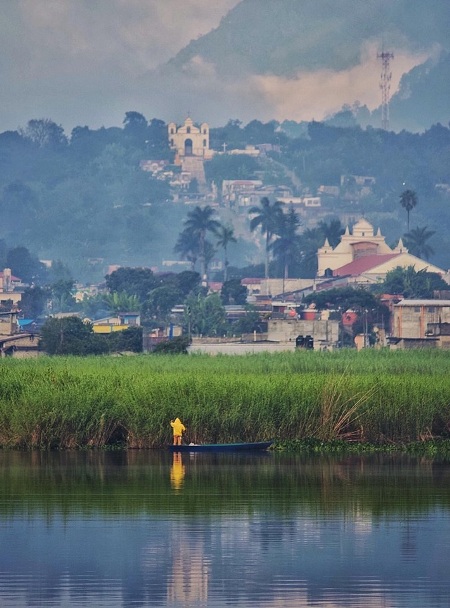
San Cristóbal Verapaz, the Chichoj lagoon, the church and the Calvary chapel
The Indian merchants arrive at the Cacique's house
"But it was not until 1537 that the Dominican fathers entered the “tierra de guerra” in order to preach the Gospel of Our Lord Jesus Christ in His true manner, that is in peace. We have, in the previous chapter explained how the fathers had taught four Indian merchants some poems, but now they went even further, setting them to music and adapting them to Indian musical instruments but in more melodious harmonies, for Indian music tends to be low-keyed and raucous. The merchants carried local wares, but Father Fray Bartolomé de Las Casas additionally gave them Spanish scissors, knives, small mirrors and the bells which Indians like so much. With these goods he sent the merchants into the pagan territory, lands controlled by a powerful cacique, a man of intelligence and good sense, related to all the leading families and, because of his warlike character, feared in the entire province where nothing ever happened unless he had sanctioned it. To this chief Father Fray Bartolomé de Las Casas directed the merchants. In those days they had no inns or hostels, and all strangers who arrived were accommodated in the chief’s house, who would receive them hospitably, offer them accommodation and feed them according to their social class. In return for a friendly reception the guest would place in front of the host such present as he was able to afford."
They sing the catechism in Tierra de Guerra
"As usual the merchants entered the chief’s house, gaining his good will with a present of Spanish-made objects, this time a wider selection than on previous occasions. They set up their stalls, customers arrived to see this time a greater variety of goods than ever before. The trading over, the merchants and the leading men of the tribe assembled, as usual, in the chief’s hall. After a while the merchants asked for a “teplanastle”, a flute-like wooden instrument with which the player produces sounds by blowing into holes. The sound made are accompanied by the beating of drums and Guatemalan rattles. The merchants began to sing the lyrics. This new occupation of the merchants, the new kind of music, were something they had never experienced before; the accompaniment of the musical instruments, so harmonious, and the consonance of word and sound surprised the listeners with their novelty. The audience also heard stories of the creation of the world, of Adam’s fall and of the divine order according to which God suffered death. This and more they heard for the first time in their lives. And they listened to the story of the Virgin birth and the miracles. They were told that their idols were demons, their sacrifices evil, particularly the offering of human beings to placate them. All this shook the chief and his nobles and filled them with something amounting to awe, similar to that which had struck the Athenians, listening to St. Paul and St. Barnabas at the Areopagus of Athens. For they had never before heard of Our Lord Jesus Christ!"
(Antonio de Remesal, Historia general de las Indias occidentales y particular de la gobernación de Chiapa y Guatemala, Book 3, Chapter 15, translated by Felix Jay, in Bartolomé de Las Casas (1474-1566) in the pages of Father Antonio de Remesal, The Edwin Mellon Press, Lewiston, 2002)
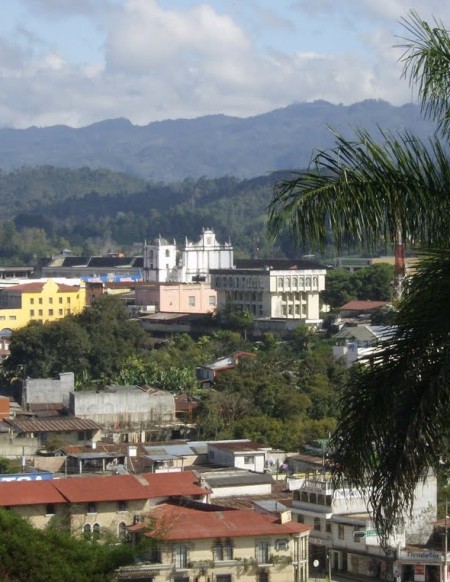
Cobán and its cathedral, as seen from the hill of the Calvario
“There is one way, an only way, to teach a living faith to all, and always; it was established by means of Divine Providence…It must be gentle, attractive, good-willed…The apostles were chosen as luminarias, examples for us to imitate…They used no arms, they were not mercenaries. They did not subjugate the world by means of physical force or by massive battalions. They did so through the preaching of Christ crucified, using simple words, loving words that have within themselves a miraculous power.”
(Bartolomé de Las Casas, De Unico Vocationis Modo, or The Only Way (ca.1533-34).
Fray Luis Cáncer de Barbastro was born in the city of Barbastro, in the Kingdom of Aragon in Spain, in a date uncertain. Most probably, he entered the Order in the Priory in Huesca, a house of the Province of Aragon. Fray Luis left his Province of Aragon around October of 1518 to become a member, as Antonio de Montesinos and Bartolome de las Casas, of the newly formed Province of the Holy Cross of the Indies on the island of Hispanola. In 1521 he traveled with Montesinos to open a new priory in San Juan, Puerto Rico, where he became its first prior.
Luis Cáncer was the first to enter the province of Vera Paz in 1542. He composed Christian canticles in the quiché language of Sacapulas and the q'eqchi' of Cobán. For four years he ministered with success in these territories. In 1546, Fray Luis Cáncer returned to Spain to recruit more missionaries. He came back with six Franciscan friars to Cobán. He had brought along with him from Mexico a group of musicians who would assist him in his ministry.
He was an ardent adherent of Las Casas and sided with him at the gathering of prelates and theologians convoked by the visitor Tello de Sandoval at Mexico in 1546. Anxious to prove the efficacy of the pacific methods of evangelization proposed by Las Casas, he went to Spain and obtained there the direction of the conversion of the Indians of Florida. He was put to death by the Indians of Tampa Bay, Florida, U.S.A. c. 1549, who knew not to distinguish him from the violent and unjust Spaniards whom they feared and hated.
The death of Friar Luis Cáncer in Florida:
"As soon a the news of the death of Hernando de Soto became known in Spain, many candidates appeared to ask for the governorship and conquest of Florida; but the Emperor Charles V refused them all, sending instead at his own cost in the year 1549 a group of Dominicans led by one of their order, Luis Cancer de Balbastro. These friars had offered to convert the Indians to the Evangelical faith with their preaching, but when they arrived in Florida and disembarked for the purpose, the natives, who had learned a lesson in their previous contact with the Spaniards, refused to listen. Instead they fell upon them and slew friar Luis as well as two of his companions. The remainder of the brothers then took refuge in their ship and, returning to Spain, proclaimed that people so barbarous and inhuman as Indians had no desire to hear sermons."
(The Florida of the Inca. A history of the Adelantado, Hernando de Soto, Governor and Captain General of the kingdom of Florida, and of other heroic Spanish and Indian cavaliers, written by the Inca, Garcilaso de la Vega, an officer of His majesty, and a native of the great city of Cuzco, capital of the realms and provinces of Peru, 1605, Chapter IV, Still others who have made the same journey to Florida.The customs and common weapons of the natives of that country)

Cobán, the cathedral and the monastery
Fray Pedro de Ángulo was born in Burgos, Spain, about 1500. After finishing his studies he set out for America in 1524. He rapidly acquired military fame, but was so much affected by the sight of the cruelties with which the Spaniards treated the Indians that he resolved to devote himself entirely to the service of the natives. With this object he entered a Dominican convent and took the habit of the order in Mexico in 1528.
After studying for some years he was ordained a priest, and accompanied Las Casas for many years into Santo Domingo, Southern Mexico and Guatemala, places where the protection of the Indians rendered their presence necessary.
Fray Pedro Angulo was one of the principal figures of the earliest Indian Missions in Verapaz. He was very proficient in two Indian languages, the Nahuatl and the Zutuhil, and wrote several tracts on religious subjects in the latter. He was one of those who, perceiving the tendency of the Indian to grasp things rather with the eye than with the ear, resorted to charts on which biblical subjects were allegorically represented. These he carried with him through the wilderness to use as illustrations for his discourses to the natives
He was made Provincial of the Dominicans for Chiapas and afterwards appointed Bishop of Vera Paz, in 1556, but before the bulls arrived from Rome he died on Good Wednesday in 1562 in Salamá, Baja Verapaz..

Cobán, Verapaz, the inhabitants ornament the city streets for Holy Week
Friar Antonio de Remesal and the Verapaz
"A half-century after the death of Las Casas, the Dominican friar Antonio de Remesal received permission from the censors in Spain to publish his Historia general de las Indias Occidentales y particular de la gobernación de Chiapa y Guatemala […]
Remesal patiently unearthed many of Las Casas’s writings, but in the process of writing the friars’s biography he created an exalted mythical personage produced by his own overheated imagination. Not even Las Casas’s own accounts of the incidents at Tuzulutlán, by then re-baptized as Vera Paz, are as given to drama as Remesal’s. It is Remesal’s mythical conception of Las Casas that was later revived by Creole patriots of the nineteenth century and kept alive by generations of reformers and academicians thereafter. […]
As Marcel Bataillon explains [in Études sur Bartolomé de Las Casas, Paris, 1965, Centre de Recherches de l’institut d’Études Hispaniques] :
Remesal invents and deforms without any other passion or design other than inventing. A narrator, a storyteller, does not lie; he simply invents, always invents. And Remesal is one of them. He has an imagination eminently realistic. When he likes an episode, he likes to describe it in time and space with the color of life."
(Daniel Castro, Another face of Empire, Bartolomé de Las Casas, indigenous rights, and ecclesiastical imperialism, Duke University Press, 2007)
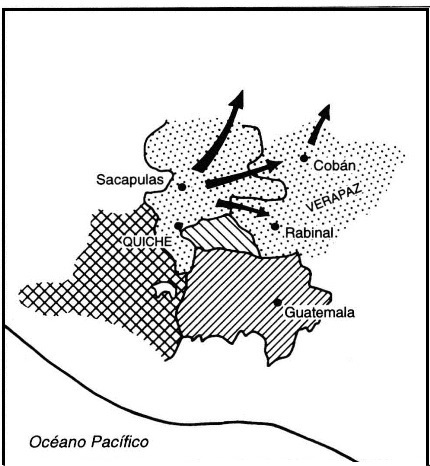

Axes of Dominican evangelization between 1538 and 1553. From Jean Piel, Las Fronteras del Istmo, 2005
Lawrence A. Clayton:
"In an earlier –fictitious, it turns out- account of Las Casas’ life [Antonio de Remesal’s History], Las Casas goes into Tuzulutlán with fellow friars, they learn to speak Kekchi and Pocomchi –two of the local dialects- and convert many caciques. The friars evangelize with great success, founding settlements and churches, teaching the rudiments of the faith with music and poetry, conveniently translated into Indians languages by the newly fluent Dominicans. […]
"Las Casas himself probably never did go into Tuzulutlán. The first Dominican friar actually to enter Tezulutlán under these new orders issued by Maldonado in 1537 was probably Fray Luis Cáncer in April or May of 1541. The true évangelizacion of the land of war did not begin in earnest until then, and by that time Las Casas had returned to Spain. Las Casas probably had not spent more than a year in Guatemala between 1536 and 1539."
(Lawrence A. Clayton, Bartolomé de las Casas, a biography, University of Alabama, Cambridge University Press, 2012)
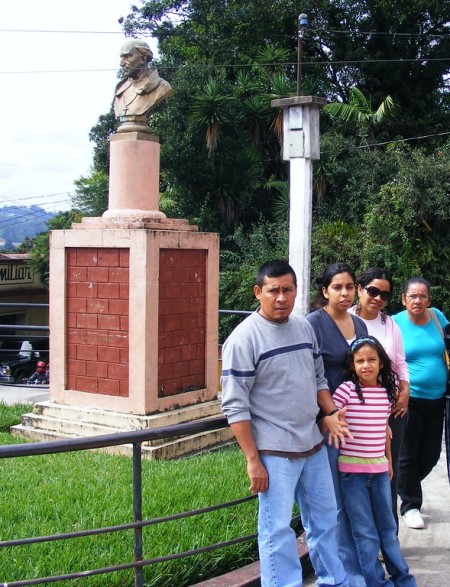
Cobán, Verapaz, Bartolomé de Las Casas park
Sepúlveda, just war against barbarians
"The Spanish have a perfect right to rule these barbarians of the New World and the adjacent islands, who in prudence, skill, virtues, and humanity are as inferior to the Spanish as children to adults, or women to men; for there exists between the two as great a difference as between savage and cruel races and the most merciful, between the most intemperate and the moderate and temperate, and, I might even say, between apes and men.
Compare, then, these gifts of prudence, talent, magnanimity, temperance, humanity, and religion with those possessed by these half-men in whom you will barely find the vestiges of humanity, who not only do not possess any learning at all, but are not even literate or in possession of any monument to their history except for some obscure and vague reminiscences of several things put down in various paintings; nor do they have written laws, but barbarian institutions and customs. Well, then, if we are dealing with virtue, what temperance or mercy can you expect from men who are committed to all types of intemperance and base frivolity, and eat human flesh? And do not believe that before the arrival of the Christians they lived in the pacific kingdom of Saturn which the poets have invented; for, on the contrary, they waged continual and ferocious war upon one another with such fierceness that they did not consider victory at all worthwhile unless they satisfied their monstrous hunger with the flesh of their perfect enemies.
Furthermore these Indians were otherwise so cowardly and timid that they could barely endure the presence of our soldiers, and many times thousands upon thousands of them scattered in flight like women before Spaniards so few that they did not even number one hundred. . . . Although some of them show a certain ingenuity for various works of artisanship, this is no proof of human cleverness, for we can observe animals, birds, and spiders making certain structures which no human accomplishment can competently imitate. . . .They have established their nation in such a way that no one possesses anything individually, neither a house nor a field, which he can leave to his heirs in his will, for everything belongs to their masters whom . . . they call kings, and by whose whims they live, more than by their own, ready to do the bidding and desire of these rulers and possessing no liberty. And the fulfillment of all this, not under pressure of arms but in a voluntary and spontaneous way, is a definite sign of the servile and base soul of these barbarians."
(Juan Gines de Sepulveda, "Democrates II, or Concerning the Just Causes of the War Against the Indians.")
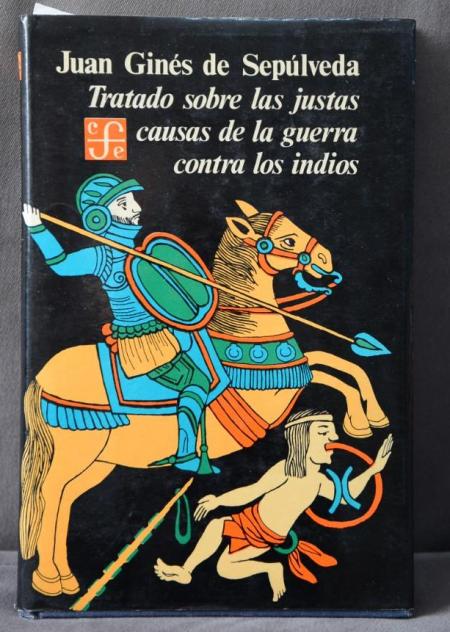
Juan Ginés de Sepúlveda, Tratado sobre las justas causas de la guerra contra los indios, Fondo de Cultura Económica, México
Soon, the war came back in Verapaz:
"In this season (1630) there was in Guatemala, Friar Francisco de Morán, the Prior of Cobán in the province of Vera Paz, who was informing the President and whole Chancery how necessary it was that some Spaniards should be aiding and assisting him for the discovery of a way from that country unto Yucatán, and for the suppressing of such barbarous people and heathens as stopped his passage, and did often invade some Indian towns of Christians.
This Morán (being my special friend, and having been brought up in Spain in the cloister of San Pablo de Valladolid, where myself was first entered friar) was very desirous of my company along with him, for the better bringing into Christianity those heathens and idolaters, telling me that doubtless in a new country new treasure and great riches was like to be found, whereof no small share and portion should befall him and me for our pains and adventure. I was not hard to be persuaded, being above all desirous to convert to Christianity a people that had never hear of Christ; and so purposed to forsake that honour which I had in the University, for to make Christ known unto that heathenish people. The Provincial was glad to see this my courage, and so, with some gifts and money in my purse, sent me with Morán to the Vera Paz in the company of fifty Spaniards, who were appointed by the President to aid and assist us. [...]
Thus I took my rest till about midnight; at which time our watches gave an alarm against our approaching enemies, who were thought to be about a thousand. They came desperately towards us, and when they saw they were discovered, and our drums beat up, and our fowling pieces and muskets began to shoot, they holloaed and cried out with a hideous noise, which uproar and sudden affrightment added sweat and fear to my fever. But Morán (who came to confess with me, and to prepare himself for death or for some deadly wound) comforted me, wishing me to fear nothing, and to lie still, for that I could do them no good, and that less was my danger than I apprehended because our soldiers had compassed me about, so that on no side the heathens could come in, and flee we could not without the loss of all our lives. The skirmish lasted not above an hour, and then our enemies began to flee back. We took ten of them, and in the morning found thirteen dead upon the ground, and of ours five only were wounded, whereof one died the next day.
In the morning our soldiers began to mutiny and to talk of returning back, fearing a worse and more violent onset that day or the night following, for some of the Indians who were taken told them plainly that if they went not away there would come six or seven thousand against them. They told us further that they knew well that the Spaniards had all the country about, except that little portion of theirs, which they desired to enjoy quietly and peaceably, and not to meddle with us, but rather if we would see their country and go through it as friends, they would let us without doing us any hurt; but if we came in a warlike manner to fight and to bring them into slavery, as we had done their neighbours, they were all resolved to die fighting rather than to yield."
(A new survey of the West-India's, or, The English American, his travail by sea and land : containing a journal of three thousand and three hundred miles within the main land of America ... : also a new and exact discovery of the Spanish navigation to those parts ... : with a grammar, or some few rudiments of the Indian tongue called Poconchi, or Pocoman / by the true and painful endevours of Thomas Gage, London, 1648, Chapter 16. Showing how and why I departed out of Guatemala to learn the Pokomchi language, and to live among the Indians, and of some particular passages and accidents whilst I lived there)
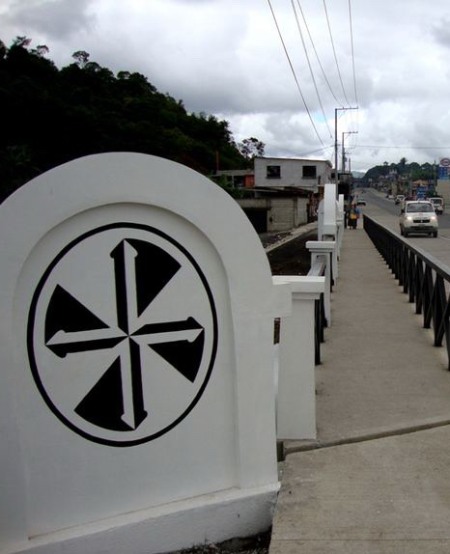
The Dominican emblem, in a street of Cobán, Verapaz
Universal History, 1788
"Between the gulf of Honduras, and the province of Guatimala, lies the province of Vera Paz, so called because the natives submitted without resistance, and maintained the treaty made with the Spaniards religiously. The extent of this province is but forty-eight leagues in length, and about half that breadth ; nor is it remarkable, either for being populous and fertile, so which the woodiness of the country, and the frequency of earthquakes, are great and insuperable impediments. As to the climate the Spanish writers affirm, that half of the province is very pleasant, healthy, and temperate, while the other half is insupportably hot ; the air participating of all the bad qualities which can be expected from heat and moisture. With all these inconveniencies, the Spaniards find it worth maintaining, upon account of the admirable medicinal gum, dying drugs, and other valuable commodities, produced here in abundance. Formerly there was gold in the Gulfo dulce, but now it is either exhausted, or so scarce as not reward the trouble of searching. The capital is Vera Paz, a city pretty enough, but no magnificently built, and emblematical of the real situation of the inhabitants, who enjoy a sufficiency to live at ease, without opulence or grandeur. This town is also called Coban by some modern travellers and geographers."
(The Modern Part of An Universal History, from the Earliest Account of Time, Volume 39, The history of America, by George Sale, George Psalmanazar, Archibald Bower, George Shelvocke, John Campbell, John Swinton, London, 1788)
2025 "Friars and Mayas"
|


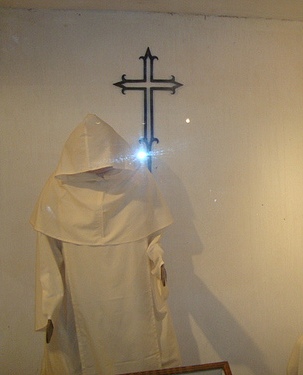
Dominican dress in the Museo del Trapiche (sugar cane factory), San Jerónimo, Baja Verapaz, Guatemala. This factory was owned by the Dominicans.
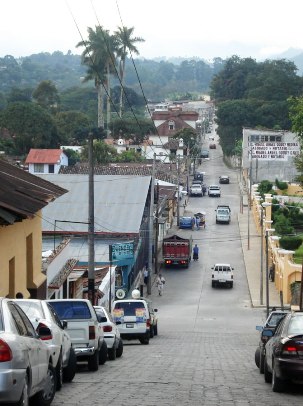
A street in Cobán, Verapaz
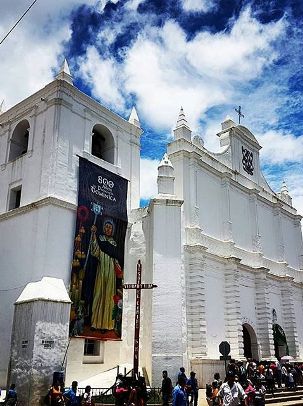
The cathedral of Cobán, former convent of Santo Domingo de Guzman. Celebration of the 800th anniversary of Dominican Order founding
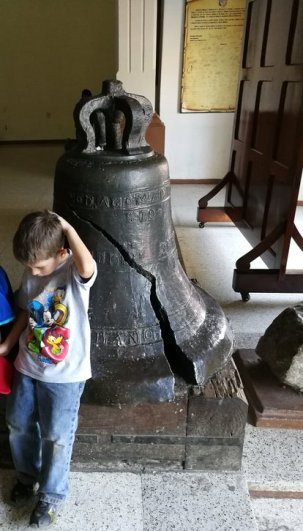
Remains of an ancient cracked church bell in the cathedral of Cobán
Agreement between Alonso Maldonado, Governor of Guatemala and Bartolomé de Las Casas (May 2, 1537)
"I, Alonso Maldonado, his majesty’s Governor of this city and province of Guatemala, state that whereas you, Father Fray Bartolomé de las Casas, vicar of the house of Santo Domingo in this city, and the Religious who are here with you, have been moved to the service of our Lord God and to the salvation of souls and also to serve his majesty, to manage and work so that certain tribes of natives Indians within the borders of this jurisdiction, who are not in obedience to our Lord King nor in conversation with the Spaniards, but rather are in rebellion and at war so that no Spaniard dares to go where they are, may come in peace, and you wish to secure and pacify them and bring them to royal subjection and dominion and that they may recognize his majesty as their lord so that they may be instructed in matter of the holy Catholic faith and thet the Cristian faith may be preached to them by you and the other Religious who hold that responsability, and you have asked me to participate and give my approval;
and whereas you fear that after you have brought the said Indians and tribes to peace and into the service of the King, if they are assigned to Spaniards they will be abused as has been customary and prevented to receiving the Christian faith and doctrine, and therefore you have demanded in the name of God and his majesty that I promise and certify in the name of the crown that all the tribes and Indians which you bring in peace and subjection to his majesty, will be designated to the crown and will not be assigned or given to any Spaniard, then you would secure them and work with alll your strength to bring them in that way, and that if I do not so promise you would not that responsability ; because you say that you cannot work fruitfully or bring them to become Cristians or to receive instruction in good customs ; and because this is a work of obvious service and glory to God for his majesty and the well-being and salvation of the native Indians of these tribes, and it is clear that his majesty desires nothing but that these infidels become Cristians and be converted to God;
therefore I state and promise you and give my word in the name and on behalf of his majesty […] that I from here, with the powers given me by his majesty, will designate to the crown all that you secure and all their tribes, so that they may serve him has his vassals, and that I will not assign anyone to any Spaniard now or at any time, and I will order that no Spaniard molest them or approach them or their lands, on grave punishment of five years, in order that they shall not agitate, offend, or impede them from your preaching and their conversion.
"